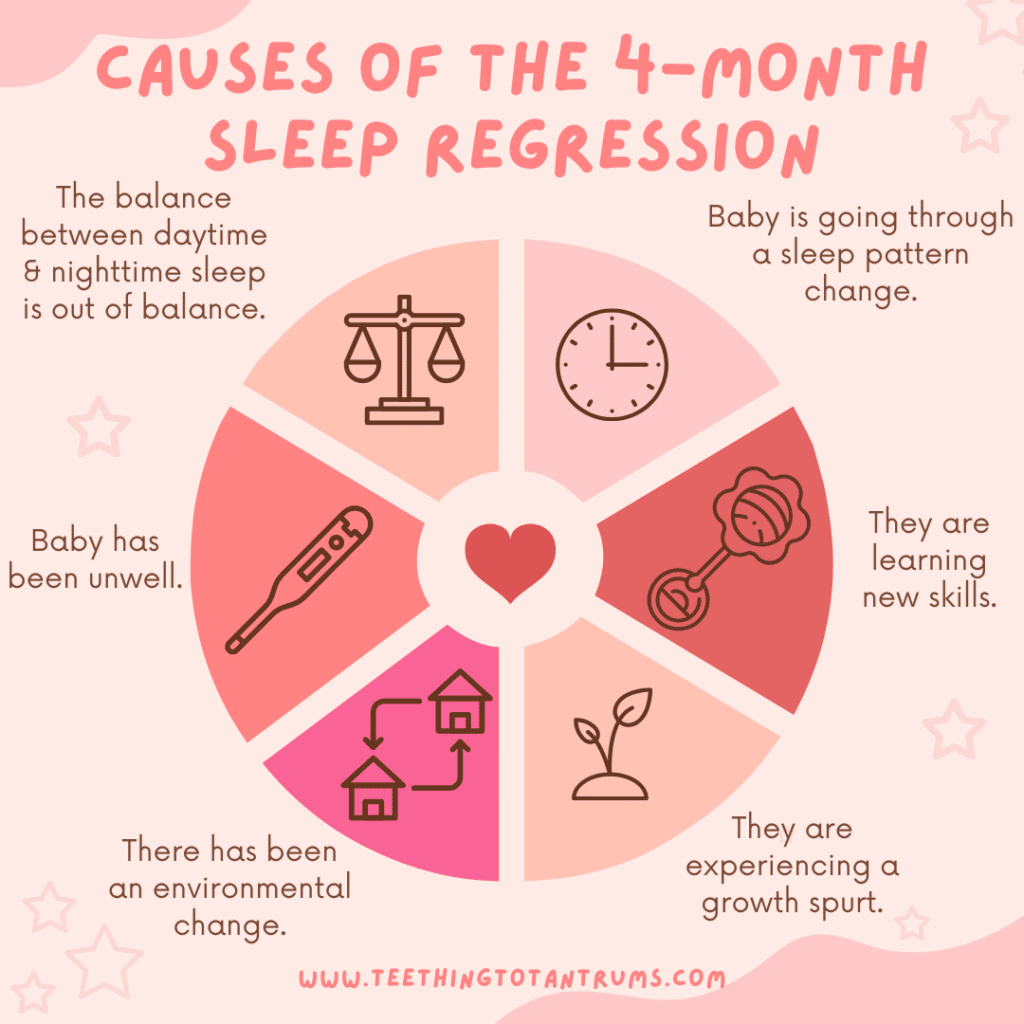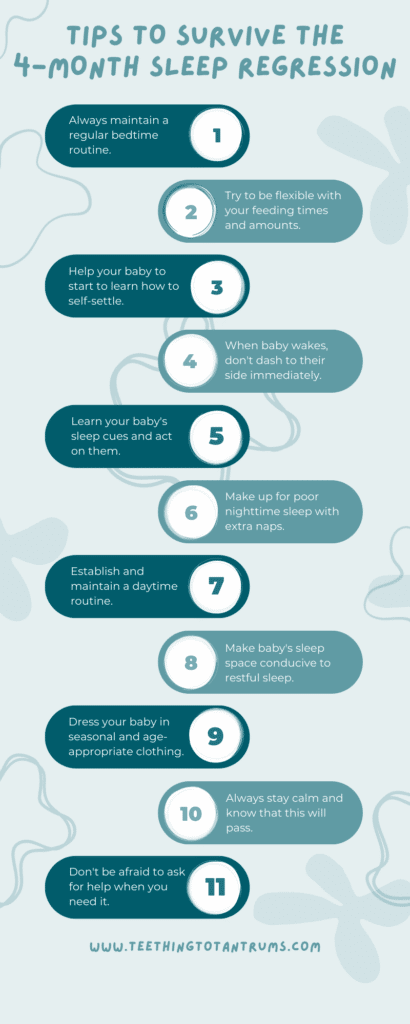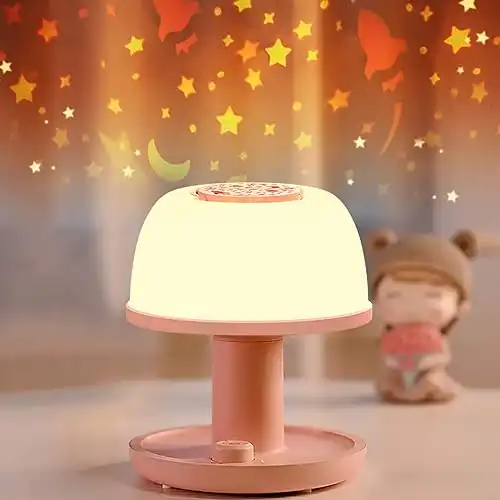Baby suddenly fighting sleep? Being fussy? Struggling to settle? The 4 month sleep regression has arrived. Here’s what that means, and what exhausted parents need to know to get through it.
What Is The 4 Month Sleep Regression?
The 4 month sleep regression is the first and most common sleep regression that you may encounter and it is defined as a period of time in which your baby’s sleep pattern becomes disrupted by them fighting sleep, waking more often and struggling to fall back to sleep at night.
How Long Does The 4 Month Sleep Regression Last?
The 4 month sleep regression, like all regressions, commonly lasts between 2 and 6 weeks depending on the trigger.
What Causes A 4 Month Sleep Regression?
The first sleep regression that occurs around 4 months of age is slightly different from regressions that occur when your child is older because it’s more defined in its cause and is usually driven by one of the following reasons:

1. A major change in your baby’s sleep patterns. As your little one moves away from newborn sleep towards a more structured sleep pattern with healthy sleep habits, a huge adjustment to their internal clocks needs to take place.
The Sleep Foundation explains that a sleep regression at 4 months occurs because ‘babies are in the midst of a major transition away from a newborn sleep pattern. That transition is not always smooth; it may have plateaus or setbacks.’
As a result, your baby will now spend more time in light sleep (also known as non-REM sleep) instead of deep sleep which causes more frequent waking.
2. They are learning new physical skills. At the 4 month mark, your little one is learning a lot about the world around them, they are babbling more, putting things into their mouths, and able to hold and shake objects and some may even start to roll over.
All of these developmental milestones and new stimulation can result in them struggling to fall asleep and stay asleep as their brain and body adjust to all this new information.
3. They are experiencing a growth spurt. If your little one is going through a growth spurt it may disrupt their natural and established schedule for a short time as they are using more energy to grow or are becoming restless.
4. There have been environmental changes. A change to their sleep associations, moving house, travelling with your baby or staying over at Granny’s can all trigger a regression.
5. Your baby has been ill. Should your little one be unwell this can also disrupt their sleep routine for a while as their normal routine is flipped upside down.
6. You’re figuring out the balance of daytime and nighttime sleep. Sometimes getting the balance between naps and nighttime sleep wrong can throw off your baby’s sleep cycle, wake windows and circadian rhythm which can trigger a sleep regression.
Looking to get your little one to sleep quickly and effortlessly? Check out my Bedtime and Nap Cheat Sheet and master the art of making daytime naps and bedtimes as seamless as possible.
A bedtime & nap cheat sheet so good your little one will ask you to put them to bed...
Laura Williams "This is a life saver! I'm so glad I downloaded your bedtime & nap cheat sheet. My little one actually asked me to put him to bed last night! Unbelievable! Thank you so much!"
Click Here For The FREE Cheat Sheet
4 Month Sleep Regression Signs
For some children a 4 month sleep regression is obvious, but for others, there are some subtle signs that indicate your little one is entering a regression.
Signs to look out for include:
1. Baby has difficulty falling asleep. If your baby has finally started to fall asleep nicely and then starts to regress to resisting sleep and struggling to settle… then it is very likely they have hit their first sleep regression.
2. Baby is more restless and fussing when waking. Because a regression results in less deep stretches of sleep your little one may wake in a grumpy mood and be rather fussy and unsettled.
3. There are more nighttime wakings and naps are shorter. As with finding it more difficult to fall asleep, it is typical during a sleep regression due to the change in their sleep pattern for your baby to wake more often at night. This may also affect how long they stay asleep during the day too.
4. Your baby is more alert and interested in their surroundings. As with learning a new skill, developing an interest in their surroundings means your little one’s brain is being very stimulated and may have a harder time winding down for sleep.
5. Your baby is learning new skills. If your baby has started to roll over, is babbling more and reaching for objects this will stimulate their brain and body to the point that they find it difficult to unwind at naptime and bedtime. You may even find that they roll over in their sleep and this wakes them.
6. They are more clingy. At around 4 months of age, your little one becomes more aware of their surroundings and more attached to those that care for them. This can result in them being more clingy and not liking being left alone especially when it is time to sleep.
Tips To Manage The 4 Month Sleep Regression
Navigating a sleep regression is no easy task, but fortunately, there are some tried and tested tips to help you get through the 4 month sleep regression as quickly and easily as possible:

1. Have a regular bedtime. Ensuring your baby gets consistent cues in preparation for sleep will go a long way in helping your little one fall asleep during a 4 month regression and a consistent bedtime routine will do just that.
2. Be flexible with feeds. It is very tempting to feed your baby in order to get them back to sleep… however, this is not a habit you want to continue. Therefore, if your baby is experiencing a growth spurt (which is very common at 4 months of age) your baby may naturally become more hungry.
Try introducing a dream feed before you go to bed to avoid night feeds and increase the length of time you breastfeed by a couple of minutes or increase bottle feeds by ½ ounce.
3. Help your baby to start to learn to self-settle. Now is a good time to teach your baby to self-settle by putting them down to nap or at bedtime when they are drowsy and not fast asleep. Try to resettle your baby with a touch or your voice rather than picking them up, rocking or feeding them.
4. Don’t dash to their side. Sometimes leaving your little one to fuss for a short time can result in them falling back into a deep sleep without you having to go to them. If they start to become distressed, however, you should go to them.
5. Learn your baby’s sleep cues and act on them. Your baby may need more sleep during the day to make up for broken nights so monitor their awake times and keep a keen eye on their sleep cues to avoid overtiredness when going through the 4 month regression.
6. Make up for poor nighttime sleep times with extra naps during the day. Let your baby sleep whenever they need to during the day to avoid them becoming overtired. Knowing how many hours of sleep your baby needs in a 24-hour period and then calculating how much daytime sleep they need will help enormously too.
7. Establish a daily routine. As your baby’s sleep cycle and circadian rhythm (linked to melatonin secretion which is also provided through breastmilk) starts to settle into a more regular pattern… 4 months is an ideal age to start a more structured sleep schedule.
8. Ensure baby’s sleep space is conducive to sleep. As your baby becomes more alert they will lose the newborn ability to sleep anywhere… So, darken the bedroom using blackout blinds and use a nightlight to create strong sleep associations.
Finding the right night light for your child can be quite a task. You want something safe, comforting, and practical. The Cozy Starry Night Light ticks these boxes, with eye-friendly warm lighting and an easy-to-use dimmer.
Its gentle glow makes it the best night light for feeding baby, diaper changes, or comforting your little one back to sleep.
As your baby grows the Cozy Starry Night Light's starry sky projection can provide comfort and gentle quiet time stimulation. Its soft lighting ensures a dreamy, peaceful environment, supporting your baby’s natural sleep cycle.
It really is a fantastic nightlight (at a very reasonable price!)
- Eye-friendly warm lighting with adjustable brightness.
- Includes a timer function for convenience.
- Projects a starry sky that is soothing for little ones.
- Rechargeable battery, so it's very portable.
- A USB adapter is not included for charging.
- The star projector is static without motion (however, this is ideal for very young babies and toddlers).
- Battery life varies based on the brightness settings.
9. Dress your baby in the correct sleep gear. Many babies of this age will no longer sleep well if swaddled. Moving to a weighted sleep sack, or sleeping bag or transitioning out of a swaddle can help with enabling your baby to sleep more peacefully and comfortably.
10. Keep calm and know that this will pass. Sleep regressions can be very distressing and exhausting but remember they are temporary by nature and will pass. The key is to hold onto as much of a routine as you can and adapt to your baby’s temporary sleep disruption.
11. Enlist help. Don’t be afraid to ask for help and share the load of broken nights and dealing with a grumpy baby during the day. By taking a break, you will be a better parent when you’re needed most. Remember, using a white noise machine can eliminate background noise from disturbing your baby’s sleep too which can be a lifesaver when you need a few minutes of peace.
White noise machines are a game-changer for your little one's sleep and having one that plays all night is a must. With a long-lasting battery, this compact and stylish white noise machine contains 21 non-stop relaxing noises, which will lull your little one to sleep night after night, no matter where you are!
REMEMBER: The 4 month sleep regression marks a permanent change in your baby’s sleep pattern. This is an ideal time to teach your little one to fall asleep independently which is an essential skill now that they have progressed beyond the newborn stage and into a phase which means they will wake more quite naturally but need to resettle themselves.
Frequently Asked Questions About The 4 Month Sleep Regression
Looking for more information about the 4 month sleep regression? Check out the most commonly asked questions here.
How Do You Break The 4 Month Sleep Regression?
Sadly, you cannot break a 4 month sleep regression… Following the tips above will help, but ultimately you will simply have to wait for the 4 month regression to pass and for your little one to settle into this new phase in their life.
Does The 4 Month Sleep Regression Affect Naps?
Yes, the 4 month sleep regression will affect naps. This is because if your little one has not had sufficient sleep during the night… they will need extra sleep during the day. You may find that your baby will sleep for less time during their morning nap, so you may have to adjust afternoon naps and bedtimes too.
Do All Babies Experience A 4 Month Sleep Regression?
No, not all babies will experience a 4 month sleep regression. However, it is the most common regression due to the fact that it is most commonly brought on by your little one moving from a newborn sleep pattern to an older baby sleep pattern accompanied by physical growth which makes them more susceptible to waking in general.
Does The 4 Month Sleep Regression Start Suddenly?
Yes, the 4 month sleep regression can start suddenly as it’s usually triggered by a sudden change in your little one’s sleep patterns resulting in erratic sleep patterns, more fussiness, less napping, more night waking and maybe changes in appetite too.
What Week Is Most Common For 4 Month Sleep Regression?
There is no specific week when your little one is more likely to experience a 4 month sleep regression. Any time between 13 and 22 weeks is when this regression may occur.
Can You Cry-It-Out During 4 Month Sleep Regression?
I personally do not recommend the Cry-It-Out Method, especially when going through a four month sleep regression. I believe you can effectively do sleep training using the Gradual Retreat and I’ll Be Back methods with great success.
So, if your little one starts to wake more frequently at night try to not rush to their side straight away, but rather wait a while to see they resettle themselves.
If that does not work and they become agitated… Respond and offer comfort by patting them on the head or tummy and using comforting words.
REMEMBER: Only pick them up as a last resort then put them down again while drowsy.
Does 4 Month Sleep Regression Make Baby Clingy?
Yes, regressions can make your baby more clingy purely because they are now more aware of their surroundings, when they are being left alone and who their significant carers are. This natural development can mean that your little one’s clinginess will contribute to the 4 month sleep regression and they will want to rely on unhealthy sleep crutches to drift off.
Is The 4 Month Sleep Regression Bad?
No, the 4 month sleep regression is not bad… It is simply a period of time in which baby’s sleep patterns are disrupted.
However, if the 4-month sleep regression is not resolved after 3 weeks, it can lead to serious sleep deprivation which can cause emotional and physical health concerns.
When Do I Need To Talk To A Doctor About The 4 Month Sleep Regression?
If you are unsure if your baby’s change in sleep patterns is due to the four month sleep regression… watch for the following signs. If they are present then you should consult a doctor, sleep expert or sleep consultant:
- Your baby is not gaining weight.
- Your baby is eating less.
- Your baby is having fewer than 4 wet diapers and 3 bowel movements a day.
- They are regularly sleeping for less than 8 hours at night.
- They are not falling into a consistent sleep pattern at all.
Need More Parenting Help?
- Download our FREE Perfect Sleep Cheat Sheet. It’s a free, easy-to-use and proven formula designed for parents of 0-5 year olds to master the art of consistently undisturbed and restful sleep without the yelling, nagging or exhausting long-winded evenings.
- Check out our Parenting Toolbox. You’ll get access to expertly-chosen products that you can guarantee are the best for your little one and your wallet.
- Ready to create the calm, peaceful evenings you deserve? Then checkout our most popular course - The Bedtime Battles Masterclass

A bedtime & nap cheat sheet so good your little one will ask you to put them to bed...
Laura Williams "This is a life saver! I'm so glad I downloaded your bedtime & nap cheat sheet. My little one actually asked me to put him to bed last night! Unbelievable! Thank you so much!"
Click Here For The FREE Cheat Sheet




